The Kashmir Great Lakes Trek, also known as the KGL Trek, is a must-have for most adventure enthusiasts visiting Trek in India. This trek is 75 km long. This trek includes mountain lakes and vast collection of meadows in the Himalayas in West Kashmir, including the famous Sonamarg hill station and Harmukh mountain The route becomes gradual as you pass Pir Panjal, Karakoram, Zanskar ranges and see some of the most magnificent landscapes in India. The KGL route takes you to major places of interest like Zaj Pass, Nichinai Pass, and Gadsar Pass. Be sure to bring a camera to capture a real heaven on earth. This is a memorable trek, start from Srinagar and take a scenic drive of 3 to 4 hours to Sonamarg. Enjoy the beauty of the Kashmir Great Lakes trek and make memories that will take you to heaven.
The Vishansar Lake is the second-largest lake in Kashmir, with a high elevation. It has clear water with high drinking water quality. Vishansar Lake is situated near Sonamarg in the Ganderbal district of Jammu and Kashmir, India. It has a maximum length of 1 km and a maximum width of 0.6 km. It can only be accessed by trekking from Sonamarg. This lake comes after we cross the Nichnai Pass during the Kashmir Great Lakes Trek. It is a well-known tourist place that has a beautiful view with lovely reflections of surrounding peaks. The lake changes color depending on the sun, clouds, and time of day. 'Vishansar', in Kashmiri, means the lake of Vishnu. This lake holds great importance for Kashmiri Pandits.
In the Kashmir Great Lakes Trek, the Vishansar Lake includes many types of fish; therefore, you can also call it home to fish, among which is the brown trout. It is also the home of rare migrant birds coming in summer across Siberia. Moreover, the lake is surrounded by lush meadows; therefore, it becomes the perfect place for local shepherds to graze their flocks of sheep and goats. The lake is an attraction for trekkers in the Kashmir Valley and includes glaciers. This is a part of the twin lakes (Vishnusar and Kishansar), which flow northwards up to Badoab and then westwards through Gurais along the Line of Control. The Vishansar Lake is the source of the Neelum River, which flows northwards up to Badoab and then westwards through Gurais.
The Vishansar Lake is situated 115 km northeast of Srinagar and 35 km from Shitkadi Sonamarg. During winter, the lake freezes, while in summer, the lush green meadow surrounding the lake is truly an amazing sight and part of the Kashmir Great Lakes Trek.
The Krishansar Lake also includes the clear water as Vishanshar Lake. It is situated near Sonamarg, at an elevation of 3,710 meters. It is located less than one kilometer northwest of Vishansar Lake and has a maximum length of 0.95 km and a maximum width of 0.6 km. Krishansar Lake is situated 115 km northeast of Srinagar and 35 km from Shitkadi, Sonamarg.
Krishansar is a Sanskrit and Kashmiri word that means "Krishna". It freezes during the winter; henceforth, it is inaccessible during the winter season due to heavy snowfall. The Kishansar Lake is covered with green, lush meadows, which attract local shepherds who graze their flocks of sheep and goats during the summer. The lake is also called the "Valley of Flowers"; the back of the valley comes under Gadasar Pass and the mountains are covered with snow. On the north side of Kashmir, this is the famous valley. After draining into a small stream, it gives rise to the Kishanganga River.
The Gadsar Lake, also known as Yamsar, is named after Yama (kala), the death and justice god of Hindus. This lake is also known as Flowers Lake. This lake is located 5,000m above sea level and is considered one of the highest-altitude lakes on the Kashmir Great Lakes Trek in the Kashmir region. One can either reach this lake from Naranag via Gangabal and Satsar, or one can start from Sonamarg and go via Nichnai and Vishansar valleys. During the summer, the lake has pleasant weather.
The Gadsar lake has many wildflowers, and the water is deep green. It is also observed that, from a certain point of view and angle, it has a heart shape. The Gadsar Lake is protected by a huge glacier, which means most of the time it has ice floating around. Locals have a belief that the Gadsar lake is very pure and divine; hence, one should not swim or dirt in this lake. Because of this, there are many myths passed along. Whether you are a local or a trekker, no one is allowed to drink the water from the Gadsar Lake.
It freezes from October to December, which means that is not a good time to visit. The name Gadsar is made of two Kashmiri words. Gad means fish, and Sar means a lake. So, the Gadsar means the lake of fish. Most days you will see rain in the evening, but when the sun comes out, it will be the best scenic landscape you will have ever seen in your life. This lake needs some extra effort, as it is said to be one of the hardest ones to cross.
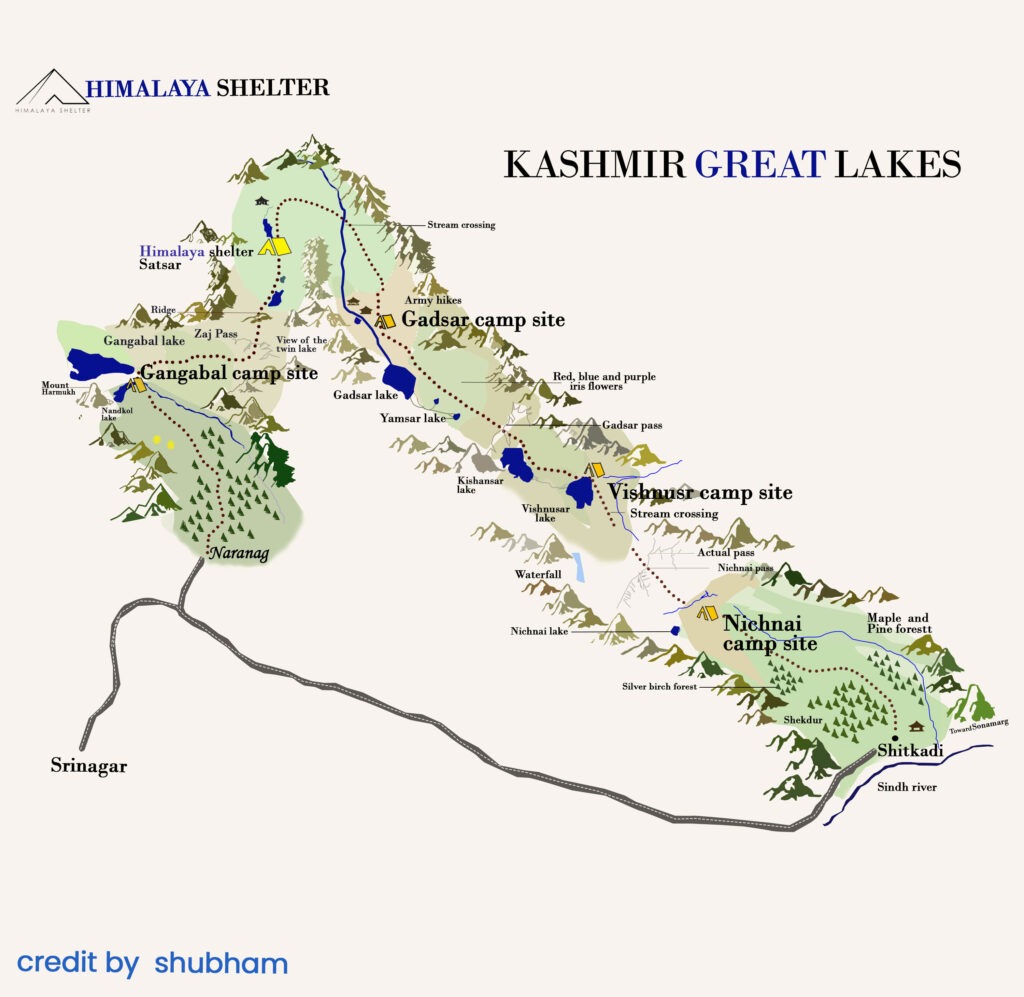
Drive: 81 km, 2-3 hrs
Trek: 0.5 km to reach the campsite
Altitude: 5,220 ft (1,590 m) – 9,022 ft (2,750 m)
Accommodation: Camping (Alpine Tents)
Meals: Dinner
We leave Srinagar around 1 PM and reach Sonamarg by 4:30 PM, following the Sind River. Once we cross over to the true right of the river at Wayil Bridge, which is 25 KM ahead of Srinagar, we encounter the Anchar lake of Srinagar on the way. The drive is a gradual climb all the way to Sonamarg, and from an altitude of 1,600 meters at Srinagar, we reach a modest altitude of slightly over 2,700 meters at Sonamarg. We will camp overnight at Shitkadi and will have to walk a short distance of 500 meters to reach our campsite.
Your trek leader will inform you in detail about the entire KGL trek, giving you all the details that you need. The campsite is located next to a stream offering a stunning view of Thajiwas Glacier. There is no sound other than the gentle music of the river.
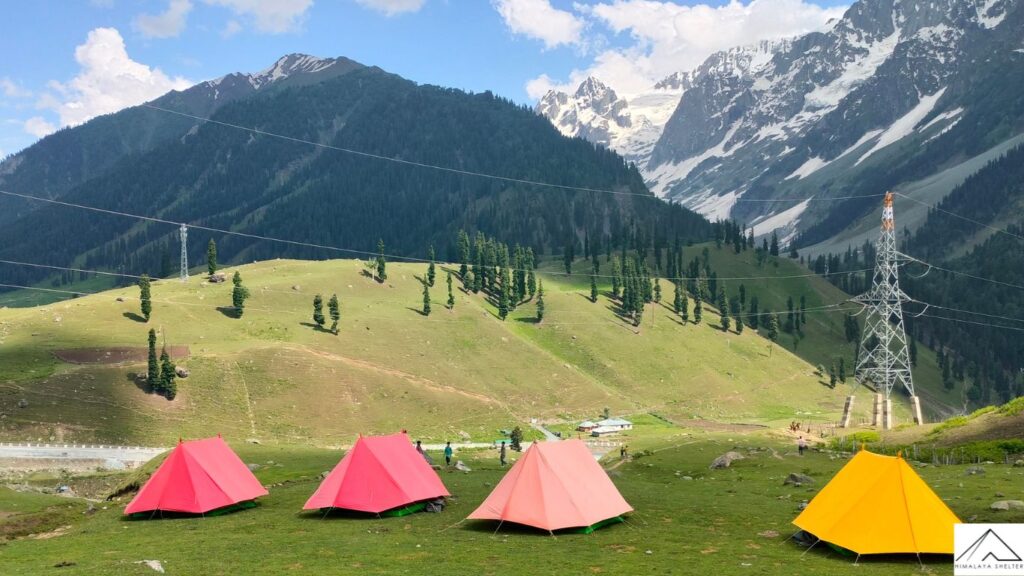
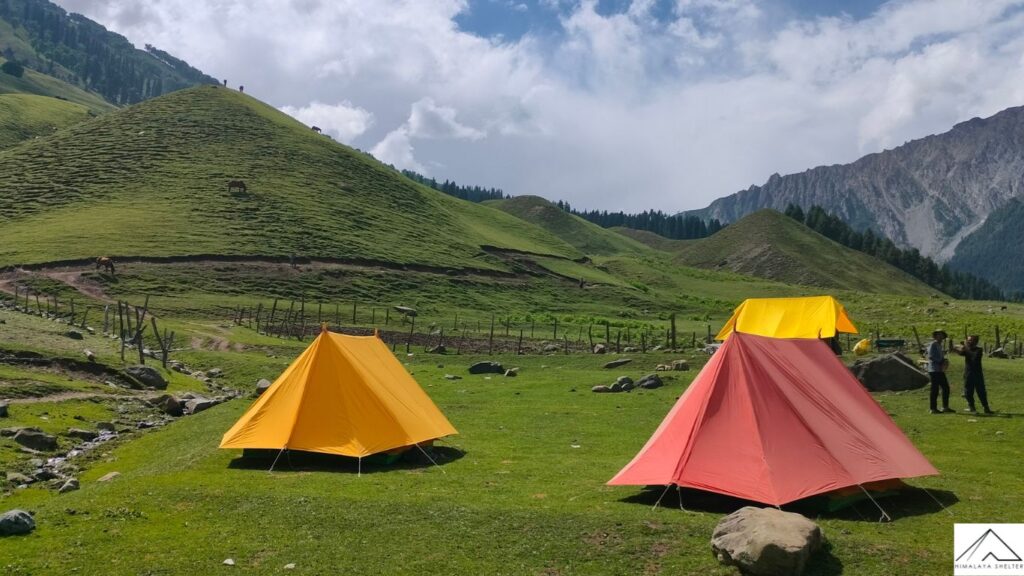
Trek: 11 km, 5-6 hrs
Altitude: 9,022 ft (2,750 m) – 11,811 ft (3,600 m)
Accommodation: Camping (Alpine Tents)
Meals: Breakfast + Lunch + Evening Snacks + Dinner
From our camp at Shitkadi, we start the trek towards the Nichinai camp. Throughout the day, we follow the Nichinai stream, which is on our right.
After a 1.5 KM trek upstream, we arrive at a meadow with maple trees dotting the landscape, along with pines. The trail continues to climb up the ridge, and as we gain more altitude, the view towards Sonamarg becomes quite picturesque.
The maples continue all the way up to the top of the ridge, lining the eastern slope of the ridge. As we reach the top of the ridge, the place is called Table Top, one of the highest points, providing spectacular views of both the Sonmarg Valley and the Amarnath Valley. From here you can engage the local people and shepherds. It is also a lunch point and you can eat Maggie and other local goodies placed by the shops around the Table Top after that an open grassland paves the way that gradually descends to some distance. To the west of the grassland, silver birch (Bhojpatra) trees stand tall, while to the east, the maples can still be seen. This meadow, known as Shekdur, runs almost 1.5 KM long. As we approach its end, the trail then enters the forest of silver birch for almost 1 KM before the treeline finally comes to an end.
Henceforth, we continue on the trail marked by patches of grassland and stone all the way to Nichinai. We are surrounded by tall mountains on either side and towards our back lie the snow-covered mountains far across the Sonamarg valley. We will reach Nichinai by early evening and set up the camps.
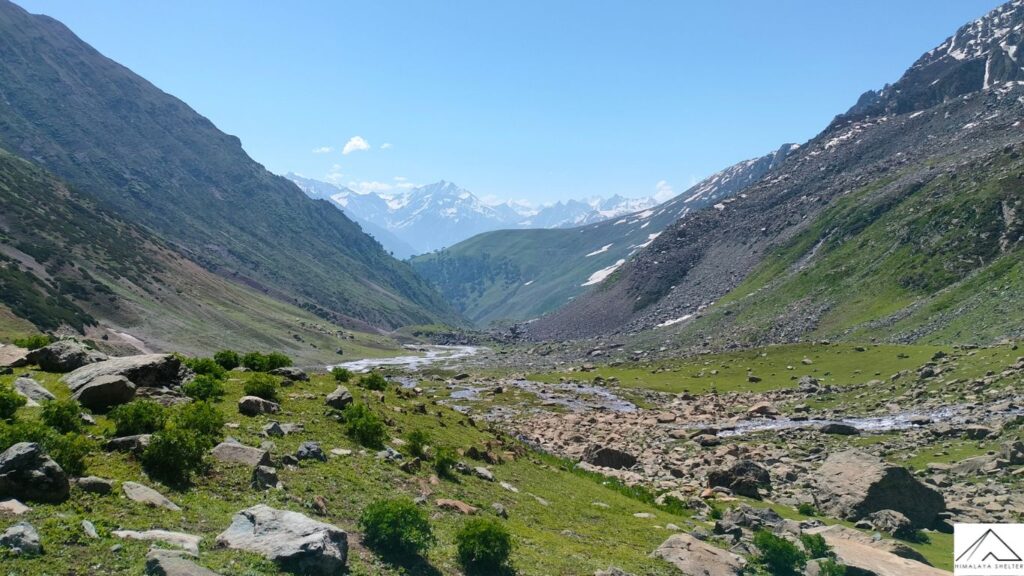
Trek: 13 km, 6 hrs
Altitude: 11,811 ft (3,600 m) – 13,100 ft (3,993 m)
Accommodation: Camping (Alpine Tents)
Meals: Breakfast + Lunch + Evening Snacks + Dinner
The trek from Nichinai camp starts with an ascent to the Nichinai Pass. The altitude of Nichinai Pass is around 13,100 Feet, which is quite close to the altitude of Hampta Pass or the Sar Pass, and higher than Kuari Pass. So, take pride in the fact that so early into the trek, you have already crossed over a pass. The ascent takes a good couple of hours to reach the pass from the campsite at a moderate pace.
As soon as we cross over the Nichinai Pass, we can see a small lake at the base of the mountain to our left. There is another larger lake, almost 500 meters in length, around 2 KM ahead, but it cannot be seen unless we climb up to the ridge to our right.
The trail continues downhill from the pass and enters grassland with a gentle slope after an hour of descent. From here, the trail is gentle up to the Vishansar Lake. It’s a few KM before we reach the base of the lake and our campsite. The lake will require another 20 mins to reach as it is slightly higher in altitude. Kishansar is further ahead of the Vishansar lake and higher in altitude still.
The lakes are quite large, and while the Vishansar runs 1.1 KM long and a little over 700 meters wide, the Kishansar is slightly smaller at 900 meters long and 550 meters wide. The latter’s shape is more of a triangular one with an inward arc on one side.
After reaching the campsite which is near the Vishansar Lake or below the Vishansar Lake, you can spend some time over there around the lake, this campsite is considered one of the best campsites of this Kashmir Great Lakes (KGL) trek
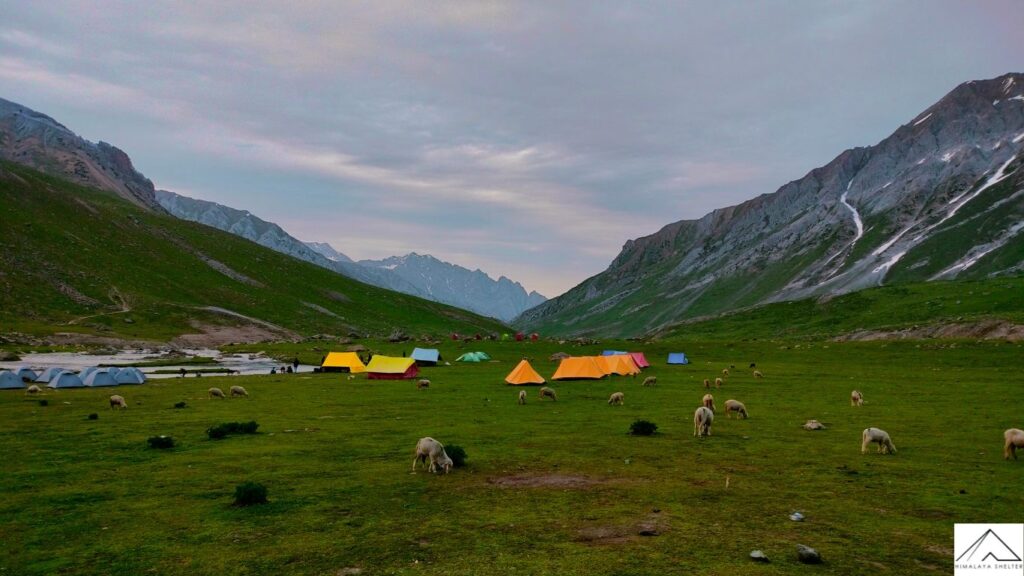
Trek: 16 km, 7-8 hrs
Altitude: 13,100 ft (3,993 m) – 13, 813 ft (4,210 m) – 12,500 ft (3,810 m)
Accommodation: Camping (Alpine Tents)
Meals: Breakfast + Lunch + Evening Snacks + Dinner
The trek from Vishansar to Gadsar is beautiful but demanding. Today’s trek will take you across the highest point of the entire trek, at a modest altitude of 4,210 meters at the Gadsar Pass.
The trail from the Vishansar campsite continues to the right, with Kishansar lake on our left as we cross it. The trail then starts climbing with a steep ascent all the way to the pass, and the trail that cuts across the mountain in zig-zags can be seen from far away.
It will take around 2 hours to reach the Gadsar Pass. As we climb higher, we are rewarded with magnificent views of the two lakes as we turn our backs. Take some time to capture these moments in your mind, as you will cherish them for the rest of your life.
As you come down from the Gadsar Pass, you will be amazed to see the beauty of Gadasr Lake. It is considered to be one of the most beautiful lakes of this trek and you can enjoy your packed lunch here while admiring the scenery.

From the Pass we can see a few smaller lakes and far off in the distance is the Gadsar lake.
Trek: 12 km, 6 hrs
Altitude: 12,500 ft (3,810 m) – 12,007 ft (3,660 m)
Accommodation: Camping (Alpine Tents)
Meals: Breakfast + Lunch + Evening Snacks + Dinner
The trek from Gadsar to Satsar starts with an initial steep hike that will take a little over an hour, After that, gradually trek on the ridge. While passing that ridge, you will witness the majestic Nanga Parbat (8,126). The trail then opens to plain meadows and a water stream. You can have your packed lunch here. Afterward, gradually ascend to rocky terrain, and after some time, you will reach the Satsar campsite
This will be a relatively easier day compared to other trek days. The KGL Trek is indeed a trek with long walking distance but today, this trek will offer you a good time to rest/explore.

Trek: 9 km, 5-6 hr
Altitude: 12,007 ft (3,660 m) – 11,482 ft (3,500 m)
Accommodation: Camping (Alpine Tents)
Meals: Breakfast + Lunch + Evening Snacks + Dinner
The trek starts with an ascent to the Zaj Pass, the trail to the Zaj Pass you have to cross the boulder’s path
The altitude of the Zaj Pass is lower than the former two passes we crossed before along the trail with an altitude of 13,228 feet, it takes 2 hours to reach the pass from the pass you can see Gangbal and Nandkul lakes
The view from the pass is very beautiful The trail descends steeply and then gradually descends, making it enjoyable to walk upon.
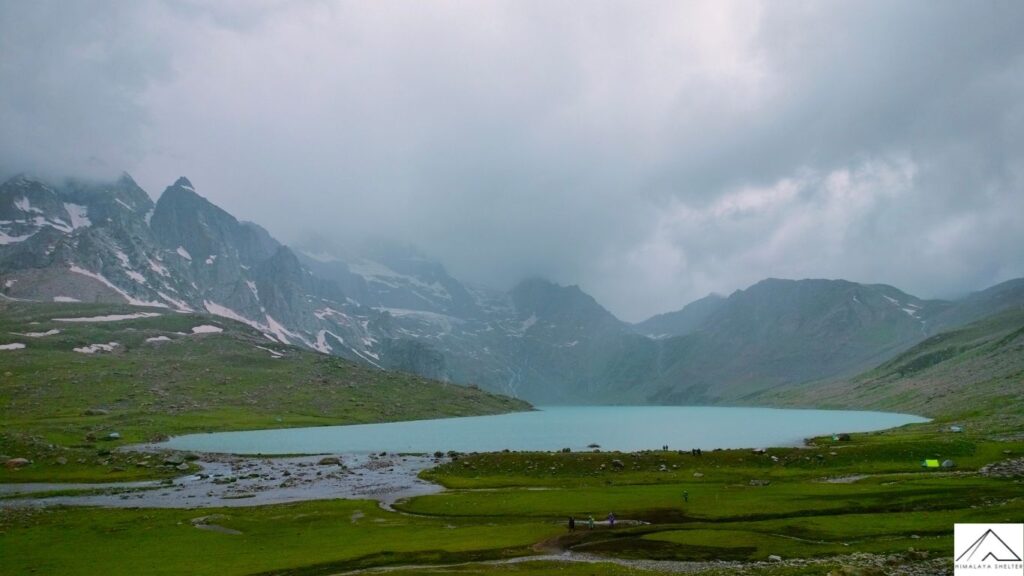
Trek: 13 km, 5-6 hrs
Drive: 50 km, 2 hrs
Altitude: 11,482 ft (3,500 m) – 7,447 ft (2,270 m)
Meals: Breakfast
On the last trekking day, after half an hour of trekking, we reached the Army check post where it took half an hour to check the documents (Adhar Card) of all the trekkers.
Then, we move ahead while the trail oscillates between minor ascents and descents up to halfway, after which there is a steep descent amid pine forests all the way to Naranag. Our beautiful Kashmir Great Lakes (KGL) Trek ends here.
We arrive in Srinagar between 5 and 7 PM, depending on the start time from Gangabal. We are sure that you will get so many pleasant memories to cherish by embarking on the KGL Trek with Himalaya Shelter.
 While Going to Vishnusar Campsite en route the Kashmir Great lakes Trek
While Going to Vishnusar Campsite en route the Kashmir Great lakes Trek
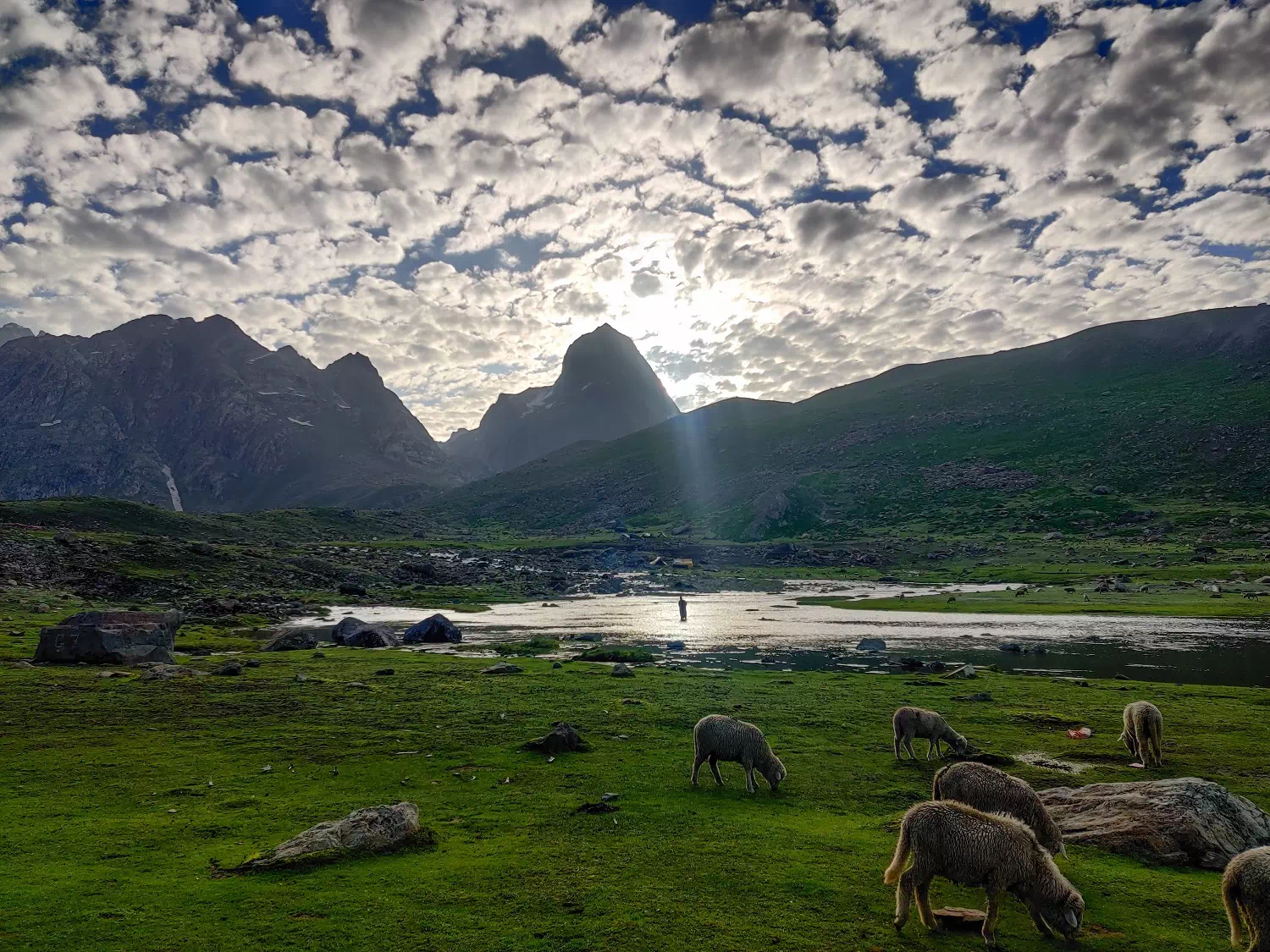 Beautiful landsacpes visible from ther Vishnusar lake campsite
Beautiful landsacpes visible from ther Vishnusar lake campsite
 Spelndid views of Vishnusar and Kishansar lake fromthe Gadsar Pass, Kashmir Great lakes Trek
Spelndid views of Vishnusar and Kishansar lake fromthe Gadsar Pass, Kashmir Great lakes Trek
 Beautiful Himalayan river flowing through the Valley en route Kashmir Great lakes Trek
Beautiful Himalayan river flowing through the Valley en route Kashmir Great lakes Trek
 Spectacular views of Gangbal and Nandkul lake en route Kashmir Great lakes Trek
Spectacular views of Gangbal and Nandkul lake en route Kashmir Great lakes Trek
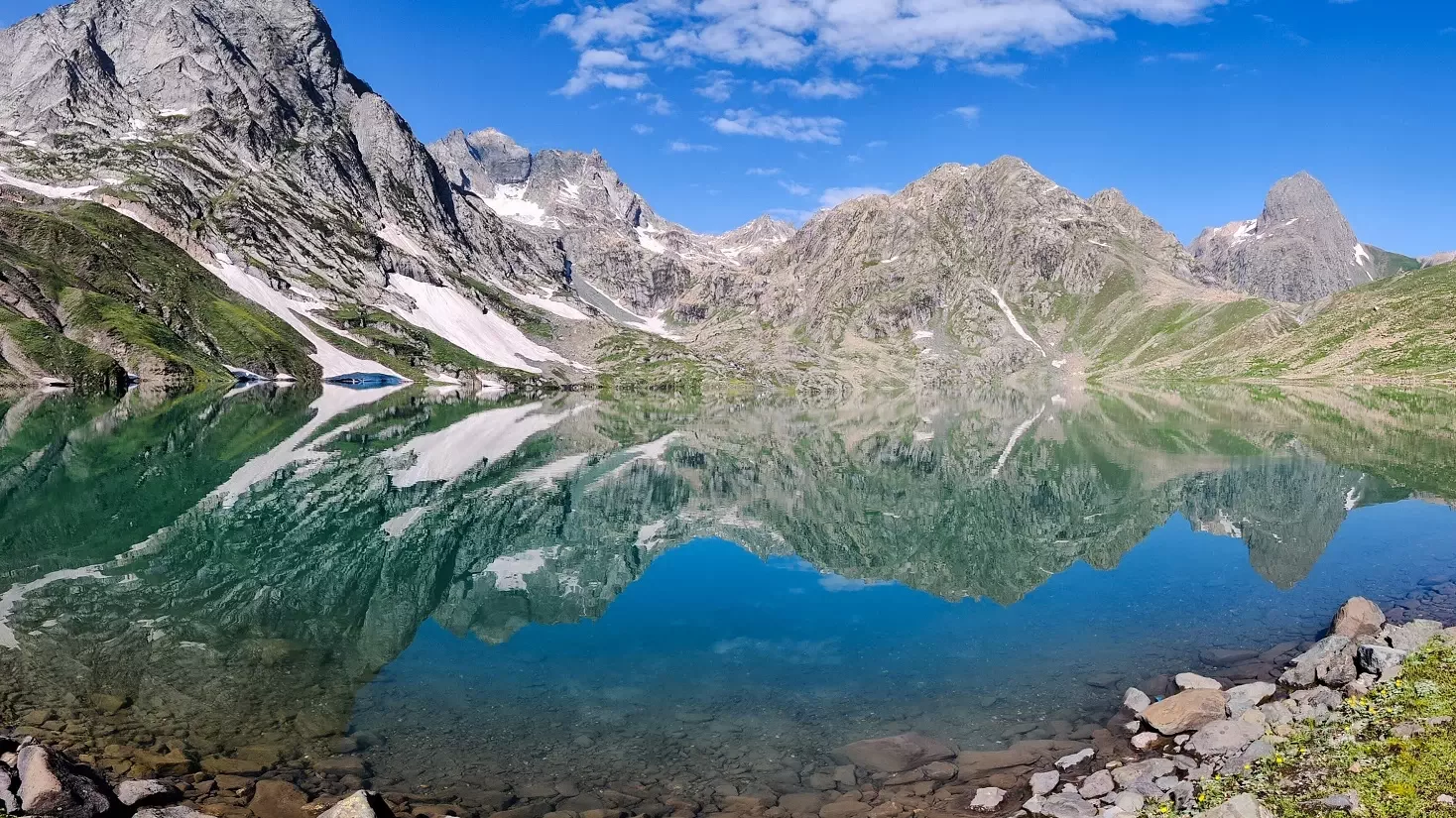 Reflection of the Himalayas over the Gangbal lake
Reflection of the Himalayas over the Gangbal lake
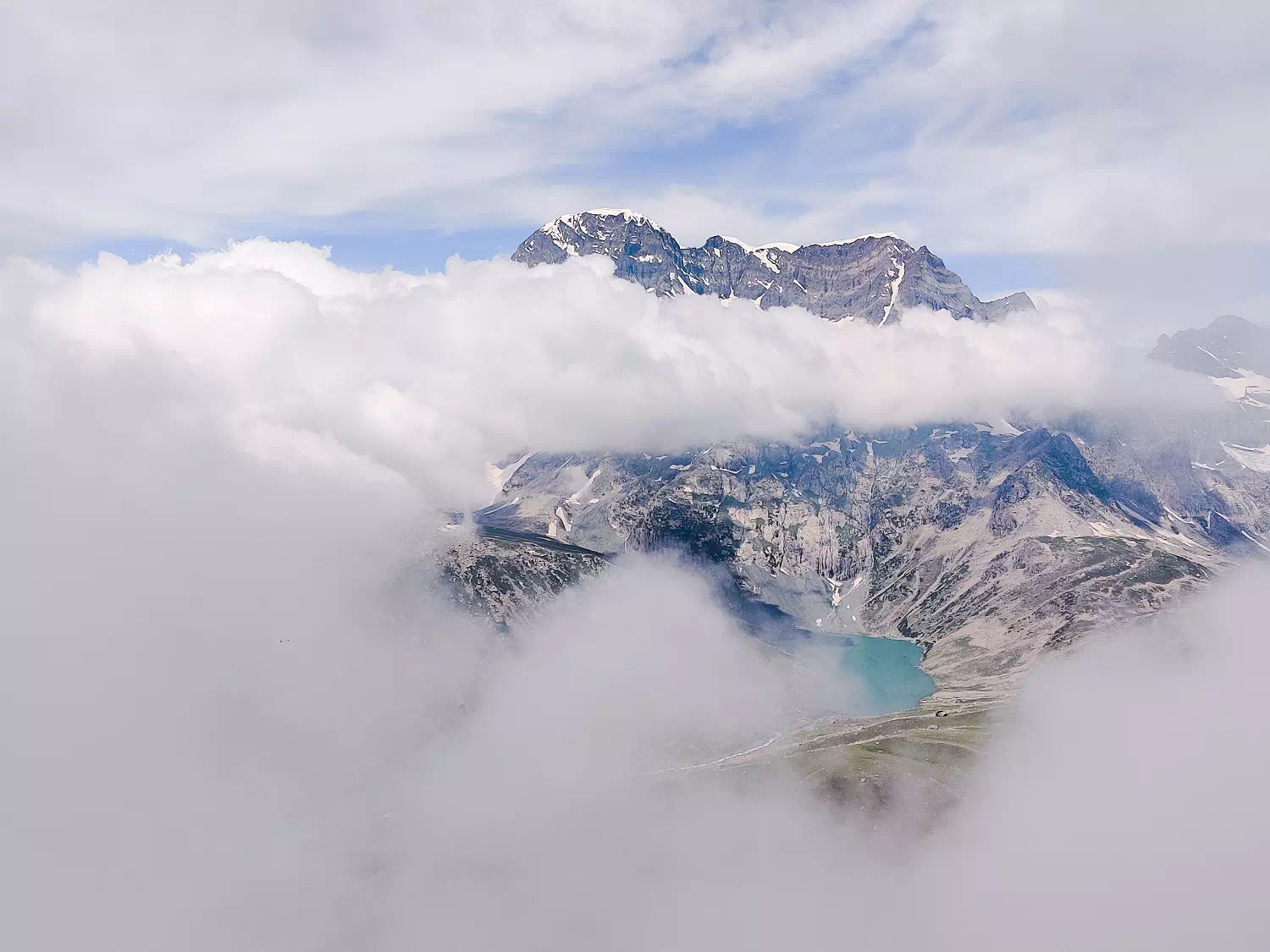 Clouds above gangbal and nandkul lake; In the months of July and August it is common to greet the clouds during the Kashmir Great lakes Trek
Clouds above gangbal and nandkul lake; In the months of July and August it is common to greet the clouds during the Kashmir Great lakes Trek
 Magnificant Vishnusar and Kishansar lake en route Kashmir Great lakes Trek
Magnificant Vishnusar and Kishansar lake en route Kashmir Great lakes Trek
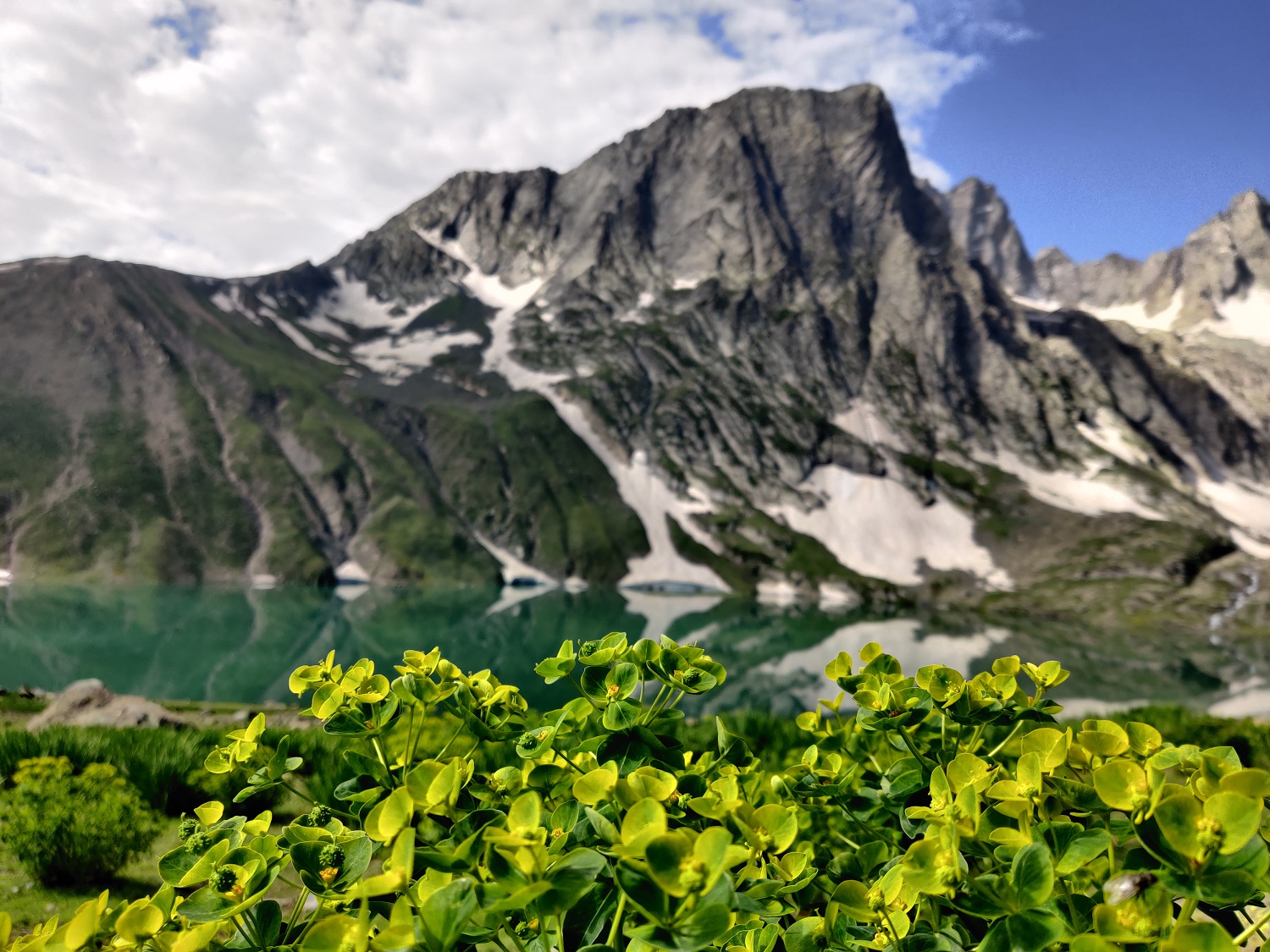 Beautiful Himalayas and Scenery en route Kashmir Great lakes Trek
Beautiful Himalayas and Scenery en route Kashmir Great lakes Trek
 Walking through the alpine meadows while going to the satsar campsite
Walking through the alpine meadows while going to the satsar campsite
 Stunning sights of high altitude Alpine Meadows Below Gadsar campsite
Stunning sights of high altitude Alpine Meadows Below Gadsar campsite
 Beautiful Landsacpes visible from the Gadsar Campsite
Beautiful Landsacpes visible from the Gadsar Campsite
 Semi frozen Gangbal lake en route Kashmir Great lakes Trek
Semi frozen Gangbal lake en route Kashmir Great lakes Trek
 Snow covered High altitude Nichnai pass en route Kashmir Great lakes Trek
Snow covered High altitude Nichnai pass en route Kashmir Great lakes Trek
 Himalaya Shelter Campsite at Nichinai Camp
Himalaya Shelter Campsite at Nichinai Camp
 T rail to Satsar campsite; Blueish Sky, Lush green meadows and a river flowing through thr Valley in the mighty Himlayas
T rail to Satsar campsite; Blueish Sky, Lush green meadows and a river flowing through thr Valley in the mighty Himlayas
The best time to visit Kashmir Great Lakes Trek is from July to September when the weather is relatively stable and the trail is clear of snow. These months offer pleasant daytime temperatures and clear skies.
While the Kashmir Great Lakes Trek is considered moderately challenging, it requires a reasonable level of fitness and hiking experience. It is recommended for individuals with prior trekking experience rather than complete beginners.
Accommodation options during the trek are limited to tents and campsites. Most trekkers carry their own camping gear, while some choose to hire equipment from local agencies. It is essential to be prepared for camping in remote areas.
The Kashmir Great Lakes Trek offers stunning views of seven high-altitude lakes. Trekkers also get to experience the beauty of Zaj Pass, Gadsar Pass, Nichinai Pass.
The Highest Altitude of the Kashmir Great Lakes will be faced while crossing the Gadsar Pass. Gadsar Pass is the highest point of the Kashmir Great Lakes Trek. It is located at a height of 13,800 ft (4,210 m). Gadsar pass, due to its high Altitude mostly remains covered in Snow.
The Beautiful Kashmir Great Lakes Trek Starts from the month of July and continues till October. It will be rainy in the months of July and August. However, you will love to do the Kashmir Great Lakes Trek in July and August since you will find that sometimes you are above the clouds and sometimes clouds are above you; you will feel as if the clouds are competing with you to complete the trek. In the months of September and October, the weather will be pleasant. In September beginning you may spot beautiful Himalayan wildflowers blooming in the Kashmir Great Lakes Trek. The month of October (especially October end) can be really cold and windy in the Kashmir Great Lakes Trek. If there will be heavy snowfall, you may not be able to cross the Gadsar Pass
Kashmir Great Lakes Trek starts from Sonmarg and ends at Naranag.
Kashmir Great Lakes Trek is a 7-day trek. However, it is advisable to keep 1 day extra as a buffer day so that you can complete the trek even if you cannot cross the Gadsar pass or Nichinai Pass due to heavy rainfall or any other unavoidable circumstances. Keeping 1 extra day can be used as an acclematisation day, too.
Kashmir Great Lakes Trek is a Moderately challenging trek where you will have to walk for at least 10-12 km every day at high altitude. Hence, a good level of Physical fitness and mental endurance are required to complete the KGL trek. Himalaya Shelter advises you to start practicing Yoga (Especially Surya Namaskar) at least two months prior to the departure Day. Running 3-4 km every day will make you fit enough to do the Kashmir Great Lakes Trek.
Kashmir Great Lakes Trek (KGL Trek) is a Moderately challenging trek where you will have to walk for at least 10-12 km every day at high altitude. If you are a first-time trekker then you may find it difficult but if you have done 2-3 Himalayan treks before, and you practice running and Yoga everyday, then you can easily complete this trek.
In total, there are 6 beautiful lakes that you will witness during the Kashmir Great Lakes Trek. All these 6 lakes are Alpine Lakes located in the High Altitude Himalayan mountains. The name of the Lakes of Kashmir Great Lake (KGL) trek are as follows: